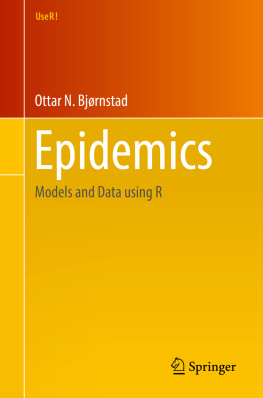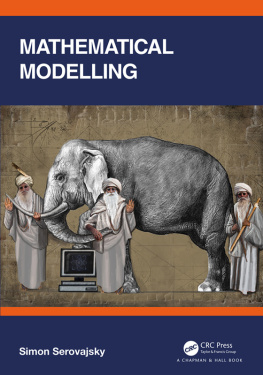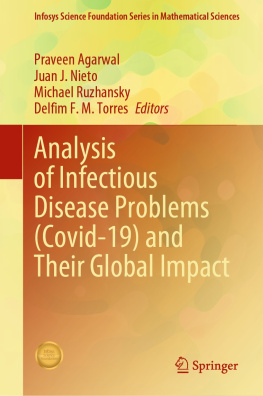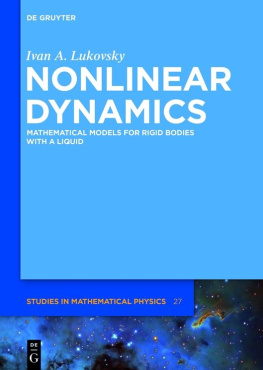Ottar N. Bjrnstad
Center for Infectious Disease Dynamics, Pensylvania State University, University Park, PA, USA
ISSN 2197-5736 e-ISSN 2197-5744
Use R!
ISBN 978-3-319-97486-6 e-ISBN 978-3-319-97487-3
https://doi.org/10.1007/978-3-319-97487-3
Library of Congress Control Number: 2018953687
Springer Nature Switzerland AG 2018
This work is subject to copyright. All rights are reserved by the Publisher, whether the whole or part of the material is concerned, specifically the rights of translation, reprinting, reuse of illustrations, recitation, broadcasting, reproduction on microfilms or in any other physical way, and transmission or information storage and retrieval, electronic adaptation, computer software, or by similar or dissimilar methodology now known or hereafter developed.
The use of general descriptive names, registered names, trademarks, service marks, etc. in this publication does not imply, even in the absence of a specific statement, that such names are exempt from the relevant protective laws and regulations and therefore free for general use.
The publisher, the authors and the editors are safe to assume that the advice and information in this book are believed to be true and accurate at the date of publication. Neither the publisher nor the authors or the editors give a warranty, express or implied, with respect to the material contained herein or for any errors or omissions that may have been made. The publisher remains neutral with regard to jurisdictional claims in published maps and institutional affiliations.
This Springer imprint is published by the registered company Springer Nature Switzerland AG
The registered company address is: Gewerbestrasse 11, 6330 Cham, Switzerland
Preface
Despite an undergraduate degree in Zoology and an MSc on the behavior of voles, I have long been fascinated by theoretical biology and the relationship between models and data, and the feedback between statistical analysis and conceptual developments in the area of infectious disease dynamics, in particular, and ecological dynamics in general. My perpetual frustration has been to read all the wonderfully clever books and journal articles exuding all sorts of nifty maths and stats, but not quite being able to do any of it myself when it came to infectious diseases that I care about. This frustration led me to attempt to make myself some worked examples of all this cleverness. Over the years the stack of how-tos has grown, and the following chapters are an attempt at organizing these so they may be useful for others. I have tried to organize the chapters and sections in a reasonably logical way: Chaps. is advanced in this respect. While less run-of-the-mill, I have thought it important to include these sections, because they cover topics that may be less easy to find code for online.
I have had invaluable help from students, colleagues, and collaborators in my quest. The preconference workshops of Ecology and Evolution of Infectious Diseases that I co-taught between 2005 and 2008 enhanced my motivation to annotate many worked examples; bare bones of several of the following sections were written during frantic 24-h stints prior to these workshops. Much of the other material arose from interactions with students and postdocs at Pennsylvania State Universitys Center for Infectious Disease Dynamics (CIDD). Parts of the epidemics on networks and the R 0 removal estimator is from Matt Ferraris PhD research, and the age-structured SIR simulator and the SIRWS model are from Jennie Lavines PhD work. Working with distributed-delay models has been a collaboration with Bill Nelson and my students Lindsay Beck-Johnson and Megan Greischar. Angie Luis and I cooked up the R code to do transfer functions as part of her PhD research. Much of the code on the catalytic model is from collaborations with Laura Pomeroy and then CIDD postdoctoral fellows Grainne Long and Jess Metcalf. The in-host TSIR was also a collaboration with Jess. The Gillespie code arose from collaborations with postdoctoral fellow Shouli Li and my honor student Reilly Mummah. Reilly also taught me how to write my first Shiny app. Away from Penn State, Aaron King and Ben Bolker have at various times been unbelievably patient in teaching me bits of maths I did not understand. Roger Nisbet painstakingly guided me through my first transfer functions during my postdoctoral fellowship at NCEAS. During the same period, Jordi Bascompte introduced me to coupled map lattice models. Finally, Bryan Grenfell showed me wavelets and introduced me to the field of infectious disease dynamics some 20 years ago.
The data used has been kindly shared by Janis Antonovics, Jeremy Burdon, Rebecca Grais, Sylvije Huygen, Jenn Keslow, Sandy Leibhold, Grainne Long, and Mary Poss. The first draft of the text was completed while I was on sabbatical at the University of Western Australia and University of Oslo/the Norwegian Veterinary Institute during 2017. My work leading up to this text has variously been funded by the National Science Foundation, the National Institutes of Health, the US Department of Agriculture, and the Bill and Melinda Gates Foundation.
Ottar N. Bjrnstad
University Park, PA, USA
May 2018









